Cigarette smoke-related hydroquinone dysregulates MCP-1, VEGF and PEDF expression in retinal pigment epithelium in vitro and in vivo
- PMID: 21386905
- PMCID: PMC3046136
- DOI: 10.1371/journal.pone.0016722
Cigarette smoke-related hydroquinone dysregulates MCP-1, VEGF and PEDF expression in retinal pigment epithelium in vitro and in vivo
Abstract
Background: Age-related macular degeneration (AMD) is the leading cause of legal blindness in the elderly population. Debris (termed drusen) below the retinal pigment epithelium (RPE) have been recognized as a risk factor for dry AMD and its progression to wet AMD, which is characterized by choroidal neovascularization (CNV). The underlying mechanism of how drusen might elicit CNV remains undefined. Cigarette smoking, oxidative damage to the RPE and inflammation are postulated to be involved in the pathophysiology of the disease. To better understand the cellular mechanism(s) linking oxidative stress and inflammation to AMD, we examined the expression of pro-inflammatory monocyte chemoattractant protein-1 (MCP-1), pro-angiogenic vascular endothelial growth factor (VEGF) and anti-angiogenic pigment epithelial derived factor (PEDF) in RPE from smoker patients with AMD. We also evaluated the effects of hydroquinone (HQ), a major pro-oxidant in cigarette smoke on MCP-1, VEGF and PEDF expression in cultured ARPE-19 cells and RPE/choroids from C57BL/6 mice.
Principal findings: MCP-1, VEGF and PEDF expression was examined by real-time PCR, Western blot, and ELISA. Low levels of MCP-1 protein were detected in RPE from AMD smoker patients relative to controls. Both MCP-1 mRNA and protein were downregulated in ARPE-19 cells and RPE/choroids from C57BL/6 mice after 5 days and 3 weeks of exposure to HQ-induced oxidative injury. VEGF protein expression was increased and PEDF protein expression was decreased in RPE from smoker patients with AMD versus controls resulting in increased VEGF/PEDF ratio. Treatment with HQ for 5 days and 3 weeks increased the VEGF/PEDF ratio in vitro and in vivo.
Conclusion: We propose that impaired RPE-derived MCP-1-mediated scavenging macrophages recruitment and phagocytosis might lead to incomplete clearance of proinflammatory debris and infiltration of proangiogenic macrophages which along with increased VEGF/PEDF ratio favoring angiogenesis might promote drusen accumulation and progression to CNV in smoker patients with dry AMD.
Conflict of interest statement
Figures


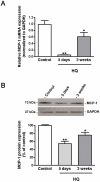
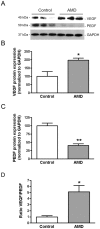
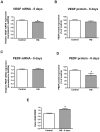
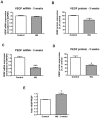
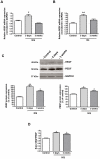
Similar articles
-
Nicotine increases the VEGF/PEDF ratio in retinal pigment epithelium: a possible mechanism for CNV in passive smokers with AMD.Invest Ophthalmol Vis Sci. 2011 Jun 1;52(6):3842-53. doi: 10.1167/iovs.10-6254. Invest Ophthalmol Vis Sci. 2011. PMID: 21330654 Free PMC article.
-
Regulation of oxidative stress and inflammatory responses in human retinal pigment epithelial cells.Acta Ophthalmol. 2022 Nov;100 Suppl 273:3-59. doi: 10.1111/aos.15275. Acta Ophthalmol. 2022. PMID: 36343937
-
PEDF expression affects the oxidative and inflammatory state of choroidal endothelial cells.Am J Physiol Cell Physiol. 2018 Apr 1;314(4):C456-C472. doi: 10.1152/ajpcell.00259.2017. Epub 2018 Jan 10. Am J Physiol Cell Physiol. 2018. PMID: 29351407 Free PMC article.
-
[Molecular mechanism of choroidal neovascularization in age-related macular degeneration].Nippon Ganka Gakkai Zasshi. 2007 Nov;111(11):881-91. Nippon Ganka Gakkai Zasshi. 2007. PMID: 18051818 Review. Japanese.
-
Pigment Epithelium-Derived Factor as a Possible Treatment Agent for Choroidal Neovascularization.Oxid Med Cell Longev. 2020 Mar 6;2020:8941057. doi: 10.1155/2020/8941057. eCollection 2020. Oxid Med Cell Longev. 2020. PMID: 32215180 Free PMC article. Review.
Cited by
-
C3a Increases VEGF and Decreases PEDF mRNA Levels in Human Retinal Pigment Epithelial Cells.Biomed Res Int. 2016;2016:6958752. doi: 10.1155/2016/6958752. Epub 2016 Sep 22. Biomed Res Int. 2016. PMID: 27747237 Free PMC article.
-
New Therapies of Neovascular AMD-Beyond Anti-VEGFs.Vision (Basel). 2018 Jul 30;2(3):31. doi: 10.3390/vision2030031. Vision (Basel). 2018. PMID: 31735894 Free PMC article. Review.
-
Oxidative stress and mitochondrial transfer: A new dimension towards ocular diseases.Genes Dis. 2020 Dec 5;9(3):610-637. doi: 10.1016/j.gendis.2020.11.020. eCollection 2022 May. Genes Dis. 2020. PMID: 35782976 Free PMC article. Review.
-
Pigment epithelium-derived factor reduces apoptosis and pro-inflammatory cytokine gene expression in a murine model of focal retinal degeneration.ASN Neuro. 2013 Nov 26;5(5):e00126. doi: 10.1042/AN20130028. ASN Neuro. 2013. PMID: 24160756 Free PMC article.
-
Mechanisms of protection of retinal pigment epithelial cells from oxidant injury by humanin and other mitochondrial-derived peptides: Implications for age-related macular degeneration.Redox Biol. 2020 Oct;37:101663. doi: 10.1016/j.redox.2020.101663. Epub 2020 Jul 29. Redox Biol. 2020. PMID: 32768357 Free PMC article. Review.
References
-
- Augood CA, Vingerling JR, de Jong PT, Chakravarthy U, Seland J, et al. Prevalence of age-related maculopathy in older Europeans: the European Eye Study (EUREYE). Arch Ophthalmol. 2006;124:529–535. - PubMed
-
- Evans JR. Risk factors for age-related macular degeneration. Prog Retin Eye Res. 2001;20:227–253. - PubMed
-
- Javitt JC, Zhou Z, Maguire MG, Fine SL, Willke RJ. Incidence of exudative age-related macular degeneration among elderly Americans. Ophthalmology. 2003;110:1534–1539. - PubMed
-
- Klein R, Peto T, Bird A, Vannewkirk MR. The epidemiology of age-related macular degeneration. Am J Ophthalmol. 2004;137:486–495. - PubMed
-
- Friedman DS, O'Colmain BJ, Munoz B, Tomany SC, McCarty C, et al. Prevalence of age-related macular degeneration in the United States. Arch Ophthalmol. 2004;122:564–572. - PubMed
Publication types
MeSH terms
Substances
Grants and funding
LinkOut - more resources
Full Text Sources
Other Literature Sources
Research Materials
Miscellaneous

